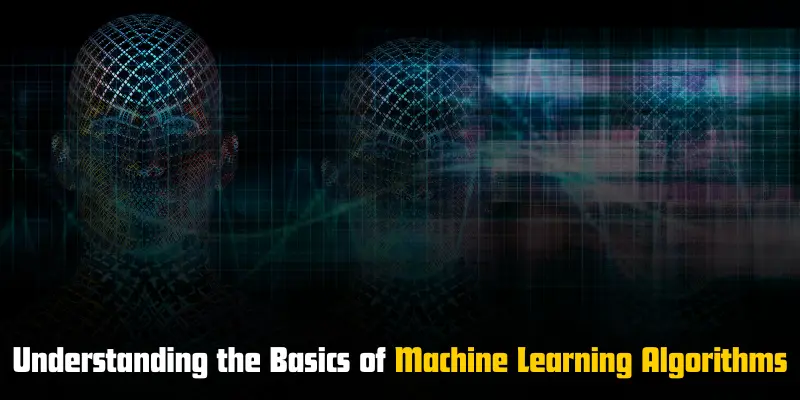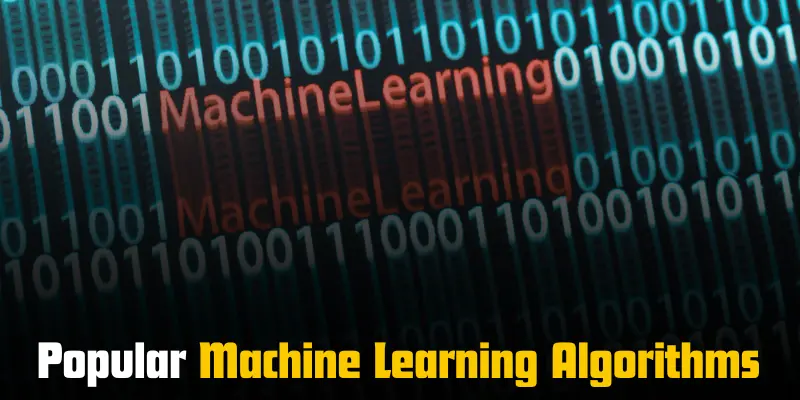Machine Learning Algorithms: A Beginner’s Guide!
Published: 5 Feb 2025
Machine learning algorithms are at the heart of many technological advancements today, from self-driving cars to personalized online recommendations. In fact, over 60% of businesses have already adopted AI-driven solutions, making it clear that machine learning is not just a trend, but a vital tool shaping industries globally. Understanding how these algorithms work can help you harness their power to solve complex problems and improve decision-making.
Introduction
Machine learning is a type of technology that allows computers to learn from data without being programmed with specific instructions. In other words, it helps computers improve their performance over time as they are exposed to more examples or information. You’ve probably already used machine learning in your daily life without even realizing it. For example, when Netflix recommends shows based on your watch history, or when your voice assistant understands what you’re saying, that’s machine learning at work!
Machine learning algorithms are the heart of this technology. They are sets of rules or steps that allow a machine to learn and make decisions on its own. These algorithms help make machines smarter by analyzing patterns in data and using those patterns to make predictions or solve problems. Without these algorithms, machines wouldn’t be able to learn from their mistakes or improve over time.
In this post, we’ll explore the different types of machine learning algorithms and explain how they work in a simple, easy-to-understand way. By the end, you’ll have a clearer picture of how these algorithms shape the technology we use every day and why they’re so important.
Understanding the Basics of Machine Learning Algorithms

What is an Algorithm?
- An algorithm is simply a set of steps or rules that help solve a problem or complete a task.
- Think of it like a recipe: you follow the steps to get a final result.
- Example: Sorting a list of numbers from smallest to largest is an algorithm.
- Step 1: Look at the first number, then the next, and decide if they’re in the correct order.
- Step 2: Repeat until all numbers are sorted.
How Do Machine Learning Algorithms Work?
- Machine learning algorithms help computers learn from data and make decisions based on patterns.
- These algorithms don’t need to be programmed with specific rules for every task. Instead, they figure out patterns by themselves.
- Key Concept:
- Learning from Data: The computer looks at lots of examples (data) and learns from them.
- Predicting/Deciding: Once the computer has learned, it can use that knowledge to make predictions or decisions about new data.
- Example: Spam Email Filter
- Step 1: The algorithm is given many examples of “spam” and “not spam” emails.
- Step 2: It looks for patterns in the emails, such as certain words, phrases, or senders.
- Step 3: The algorithm uses what it learned to decide if a new email is spam or not.
- Outcome: The more emails the algorithm sees, the better it gets at recognizing spam.
Types of Machine Learning Algorithms
Supervised Learning
- Definition: In supervised learning, the algorithm learns from data that is already labeled, meaning the answer is provided for each example. The algorithm uses this data to make predictions or decisions based on new, unseen data.
- Example: Let’s say we want to predict house prices. We feed the algorithm data about houses, like size, number of rooms, and location, along with the price for each one. Over time, the algorithm learns to predict the price of a house based on these features.
- Real-life Example: One of the most common uses of supervised learning is email classification. The algorithm is trained to recognize what constitutes a “spam” email versus a “non-spam” email by looking at features like keywords, sender, and subject. As it learns, it becomes better at sorting your inbox!
Unsupervised Learning
- Definition: Unlike supervised learning, unsupervised learning works with data that has no labels. The algorithm tries to find hidden patterns or groupings within the data without knowing the answer in advance.
- Example: Imagine you have a dataset of customers who bought products. The algorithm might group customers based on similar behavior, like frequent buyers versus occasional shoppers, without anyone telling it what those groups should be.
- Real-life Example: Netflix uses unsupervised learning to recommend movies or TV shows. By analyzing the behavior of other viewers who watched similar content, Netflix suggests movies you might like, even if you never explicitly said what you want to watch.
Reinforcement Learning
- Definition: In reinforcement learning, the algorithm learns by interacting with its environment and receiving feedback based on its actions. It uses rewards and penalties to learn which actions lead to the best outcomes.
- Example: Imagine a robot learning to walk. It starts by trying random movements, and each time it takes a correct step, it gets rewarded. Over time, the robot learns which movements are best to keep moving forward.
- Real-life Example: Self-driving cars use reinforcement learning to navigate roads. The car learns by making driving decisions (like when to stop, turn, or accelerate) and gets feedback based on whether those decisions keep it safe or not. With each driving experience, it gets better at navigating.
Popular Machine Learning Algorithms

Linear Regression
- What is it?
- Linear regression is a simple machine learning algorithm used to predict a value based on a straight-line relationship between variables.
- It works by finding the relationship between a dependent variable (the outcome) and one or more independent variables (the inputs).
- How It Works:
- The algorithm draws a straight line (or plane in higher dimensions) through the data points to predict future outcomes.
- The goal is to minimize the difference between the predicted values and actual values (called the “error”).
- Example:
- Predicting Salary: Imagine predicting a person’s salary based on their years of experience. The more experience they have, the higher their salary, and this relationship can be plotted as a straight line.
- When to Use:
- Use when you need to predict a continuous value (like price, salary, or temperature) based on past data.
Decision Trees
- What is it?
- A decision tree is a tree-like model used to make decisions by splitting data based on certain conditions or features.
- It breaks down a decision-making process into smaller, easy-to-understand steps.
- How It Works:
- At each step (or “node”), the algorithm splits the data into two groups based on the most significant feature (e.g., age, income).
- The process continues until the data is fully split, with each “leaf” representing a final decision or prediction.
- Example:
- Loan Approval: A bank uses a decision tree to decide whether to approve a loan. It looks at factors like credit score, income, and age. For example, if a person has a high credit score and stable income, they might be approved for a loan.
- When to Use:
- Use when you need to make decisions based on a series of conditions or rules. It’s especially helpful for classification problems (like yes/no decisions).
K-Means Clustering
- What is it?
- K-Means clustering is an unsupervised learning algorithm that groups similar data points together into clusters based on shared characteristics.
- The algorithm divides data into K groups (clusters) without any prior labels.
- How It Works:
- The algorithm starts by choosing K random points as the center of each cluster.
- It then assigns each data point to the nearest cluster center and recalculates the center based on the points in each group.
- This process repeats until the clusters stabilize (i.e., the center points no longer move).
- Example:
- Grouping Fruits: If you have data on various fruits with features like weight, color, and size, K-Means could group them into categories like “apples,” “oranges,” and “bananas.”
- When to Use:
- Use when you want to discover natural groupings in data, like customer segmentation or organizing items into categories.
Neural Networks
- What is it?
- Neural networks are a class of algorithms inspired by the human brain. They consist of layers of interconnected nodes (or “neurons”) that work together to solve complex problems.
- They are especially powerful for tasks like image recognition, natural language processing, and speech recognition.
- How It Works:
- Data passes through multiple layers of neurons, where each layer performs a calculation based on the input data.
- The network “learns” by adjusting the connections between neurons, improving its ability to make accurate predictions over time.
- Example:
- Face Recognition: Neural networks are used in facial recognition technology. The network learns to identify different features of faces (like the shape of eyes or nose) and can later recognize faces in images or videos.
- When to Use:
- Use for tasks that require learning from complex data, like recognizing patterns in images, text, or sound.
How to Choose the Right Machine Learning Algorithm
Choosing the right machine learning algorithm depends on several key factors. By considering these aspects, you can select an algorithm that fits your problem and data.
Type of Data (Labeled or Unlabeled)
- Labeled Data (Supervised Learning)
- If your data comes with labels (the correct answers are already provided), you can use supervised learning algorithms.
- Example: If you’re predicting whether an email is spam or not based on features like subject, sender, and body content, the data would already be labeled as “spam” or “not spam.”
- Unlabeled Data (Unsupervised Learning)
- If your data doesn’t come with labels, you will need unsupervised learning algorithms to find patterns or groupings within the data.
- Example: If you want to group customers into different segments based on purchasing habits without knowing the segments beforehand, unsupervised algorithms like K-Means Clustering would be useful.
Complexity of the Problem
- Simple Problems
- If your problem is straightforward, like predicting a price based on a few variables, simple algorithms like Linear Regression or Decision Trees may be enough.
- Example: Predicting house prices based on features like square footage and location.
- Complex Problems
- For more complex problems, such as classifying images or recognizing speech, you may need more advanced algorithms like Neural Networks.
- Example: Identifying objects in photos or understanding spoken language requires deep learning algorithms.
Size of the Dataset
- Small Dataset
- If you have a smaller dataset, algorithms like Linear Regression or Decision Trees may work well, as they don’t require a lot of data to perform effectively.
- Example: A dataset of 100 customers with their purchase history may be suitable for a decision tree.
- Large Dataset
- For larger datasets, more complex algorithms like Neural Networks can scale better and handle the large volume of data.
- Example: A dataset of millions of images for facial recognition needs a deep learning algorithm that can handle vast amounts of data.
Speed and Efficiency
- Faster Models
- Some algorithms are faster to train and make predictions, such as Linear Regression or Logistic Regression. These are ideal if you need quick results on a small dataset.
- Example: A simple sales prediction based on a few features can be done quickly with these algorithms.
- Slower Models
- More complex algorithms like Neural Networks take more time to train, especially if the dataset is large. However, they tend to produce better results for complex problems.
- Example: Training a neural network to recognize faces or objects in large images can take hours or even days.
Tip for Beginners:
Start with simple algorithms like Linear Regression or Decision Trees, especially when you’re new to machine learning or dealing with smaller, simpler datasets. If you find that your model isn’t performing well or your problem is more complex, consider trying more advanced algorithms like Neural Networks.
Conclusion
So guys, in this article, we’ve covered Machine Learning algorithms in detail. We’ve looked at key algorithms, their applications, and how to choose the right one for your problem.
If you’re just getting started, I highly recommend practicing with simpler models like Linear Regression and gradually moving on to more advanced algorithms as you gain experience.
It’s important to stay patient and experiment with different algorithms. Ready to dive deeper? Check out some beginner-friendly tutorials and start building your first machine learning model today!
Frequently Asked Questions (FAQs)
In supervised learning, the algorithm is trained on labeled data, meaning the correct answers are already provided. Unsupervised learning, on the other hand, uses data without labels and finds patterns or groupings on its own. For example, clustering customers based on purchasing habits is unsupervised learning.
While coding helps a lot, you can start with beginner-friendly tools like Google Colab or Kaggle, which offer free access to machine learning environments with little coding required. Understanding basic programming concepts can help, but you can start with simple tasks and gradually learn. There are many online resources to guide you along the way.
Some of the easiest algorithms to start with are Linear Regression, Decision Trees, and K-Nearest Neighbors (K-NN). These algorithms are simple to understand and can be applied to a wide variety of problems. Once you’re comfortable with these, you can move on to more complex models like Neural Networks.
Start by considering the type of data you have (labeled or unlabeled) and the complexity of your problem. For example, if you have labeled data, supervised learning algorithms like Linear Regression work well. If you’re unsure, start with simpler algorithms like Decision Trees and test how well they perform before moving to more advanced ones.
Overfitting happens when a model learns the details of the training data too well, including noise and errors, which makes it perform poorly on new data. To avoid it, you can use techniques like cross-validation, regularization, or pruning decision trees. Keep your model simple and test it on unseen data to check for overfitting.
Yes, many machine learning algorithms can be used for real-time predictions, such as recommendation systems on websites like Amazon. For example, Neural Networks can help with real-time tasks like recognizing speech or images. However, the speed and efficiency depend on the complexity of the model and the amount of data.
The time it takes to learn machine learning varies depending on how deep you want to go. For basic understanding, you can get started in a few weeks with online tutorials and beginner courses. However, mastering machine learning and applying it to complex problems can take months or even years.
Data is essential for machine learning because it is the foundation upon which algorithms learn. Good quality data allows algorithms to make accurate predictions or decisions. Without enough data or with poor data quality, the model’s performance can be poor.

- Be Respectful
- Stay Relevant
- Stay Positive
- True Feedback
- Encourage Discussion
- Avoid Spamming
- No Fake News
- Don't Copy-Paste
- No Personal Attacks

- Be Respectful
- Stay Relevant
- Stay Positive
- True Feedback
- Encourage Discussion
- Avoid Spamming
- No Fake News
- Don't Copy-Paste
- No Personal Attacks



